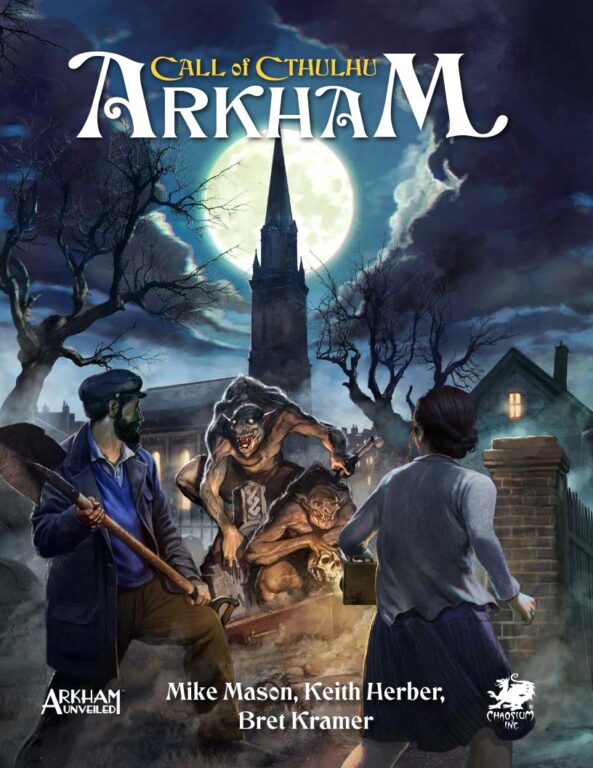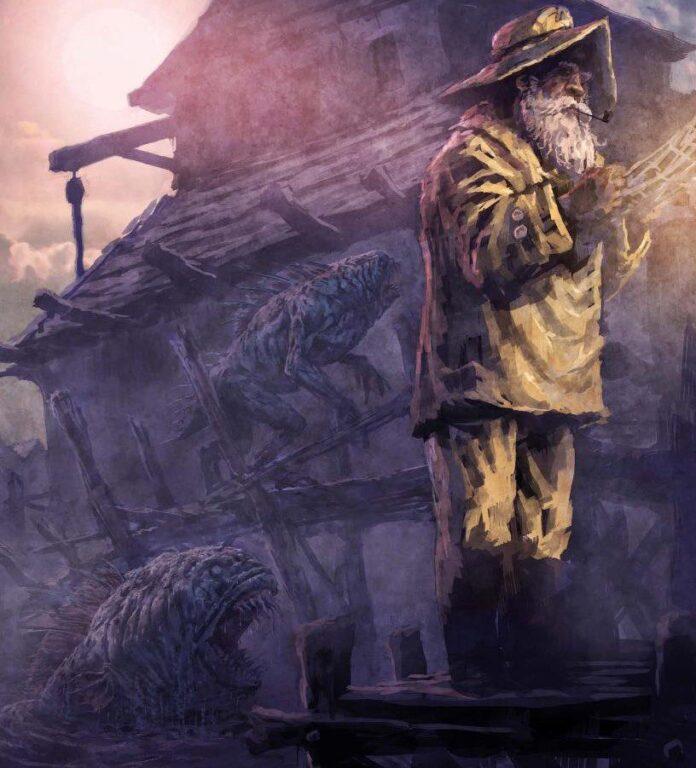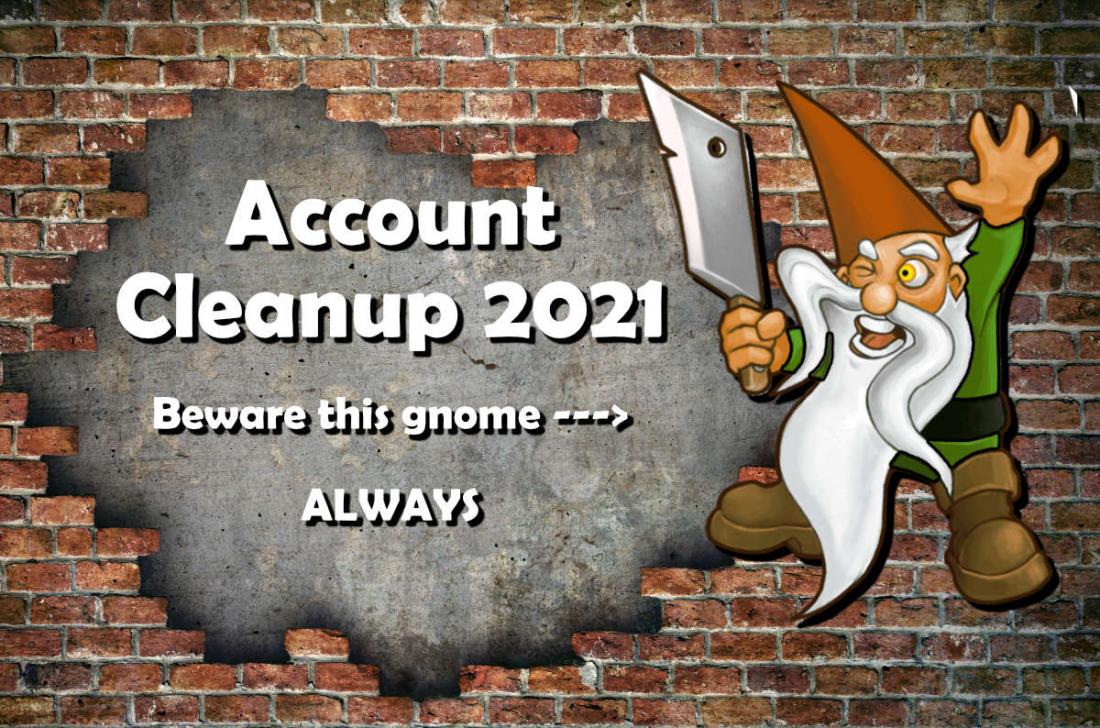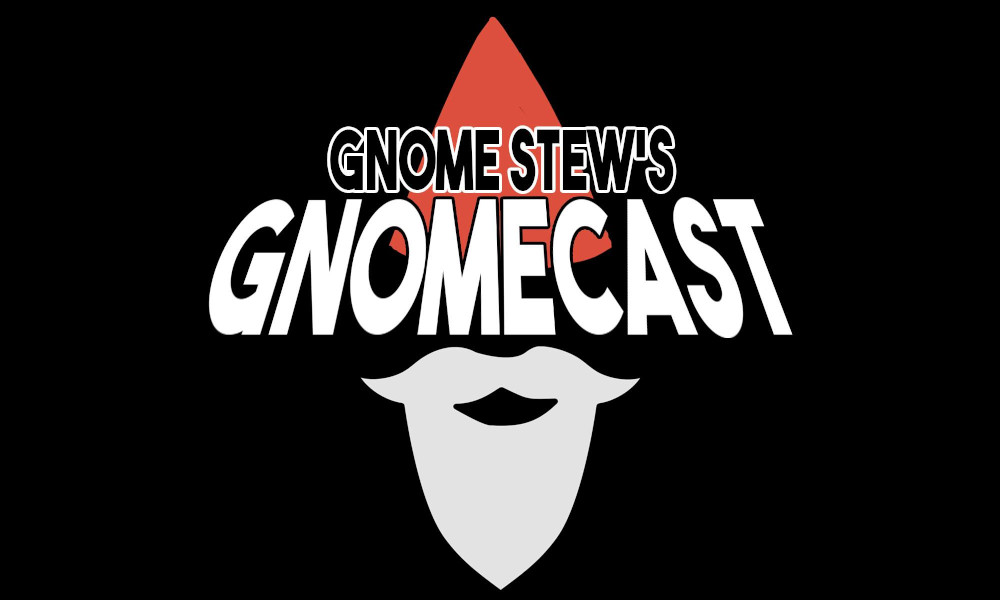
The name Arkham has become entrenched in the public consciousness, even when people don’t know the origin of the name. When I mentioned what I was reviewing this week, my wife said, “Arkham, isn’t that an asylum?” Beyond providing the name of the infamous DC Comics institution, the recurring use of a handful of fictitious towns geographically close to one another, all suffering from supernatural phenomenon, is a convention adopted by Stephen King.
The city of Arkham has been detailed in many products involving the Cthulhu Mythos, but there have specifically been two previous supplements produced by Chaosium for the Call of Cthulhu Roleplaying Game. These include Arkham Unveiled in 1990 and H.P. Lovecraft’s Arkham in 2003.
Today, we’re going to look at Call of Cthulhu–Arkham, a brand-new treatment of the eponymous location.
Disclaimer
I was provided a review copy of this product by Chaosium and have received review copies from Chaosium in the past. I have not had the opportunity to use any of the material in this book. I have played Call of Cthulhu in both 6th and 7th edition iterations, although most of that experience has been with convention play. I have run other systems using elements of the Cthulhu Mythos as well.
Call of Cthulhu – ArkhamAuthors (1990 & 2003 editions) Keith Herber, Mark Morrison, Richard Watts, Mervyn Boyd, Lynn Willis, and John B. Monroe
Authors (2024) Mike Mason, Keith Herbert, Bret Kramer
Editorial Mike Mason and Bret Kramer
Initial Development & Additional Material Bret Kramer
Copy Editing and Proofreading Ken Austin and Susan O’Brien
Art Director Kuba Polkowski Cover Art Loïc Muzy
Interior Art Helge C Balzer, Irene Cano with Kasia Smalara, Nicholas Grey, Joel Chaim Holtzman, Ania Jarmołowska, François Launet, Wayne Miller, Loïc Muzy, Martyna Starczewska, John Sumrow, and Aleksander Zawada
Layout and Graphic Design Adam Szelążek, Loïc Muzy Cartography Matt Ryan
Arkham Advertiser Newspaper “prop” and Period Advertisements Andrew Leman and Sean Branney (The H. P. Lovecraft Historical Society)
Licensing Daria Pilarczyk Marketing Director Brian Holland Producer Daria Pilarczyk
Call of Cthulhu Creative Director Mike Mason
Additional Art: Edge Studio – Asmodee Group. Used with permission.
Exploring the Tome
This review is based on the PDF version of the product, which is 274 pages long. It includes full color art, including two-page spreads of artwork introducing each chapter, half page artwork depicting various events and situations mentioned in the text, and many NPC portraits. I’ve looked at older edition Call of Cthulhu supplements, as well as earlier Call of Cthulhu 7e books, and the formatting is subtly different in this book, and I like it. For a dense book of information, the design decisions make this book easier to peruse.
A noteworthy section in this book is the Clear Credit page, which touches on all the previous Call of Cthulhu work that has been referenced going back to the beginning of the game. The book also includes a title page, a credits page, a dedication, and a table of contents. The appendices summarize the timeline of the city, collect game aids, such as random generators and common costs, a bibliography, and an index of maps. There are also biographies for the author working on the current version and the primary author of the previous version, from which much of this version was derived.
I didn’t have access to the physical versions of the books, but there is a standard hardcover, and a leatherette cover version in blue and yellow.
Structure
The book is divided into five chapters:
- An Overview of Arkham
- Arkham Investigators
- Arkham Miscellany
- Guide to Arkham
- Appendices
The bulk of the book is the Guide to Arkham, which includes hundreds of numbered locations on the maps of the Arkham neighborhoods, with details about each location and NPCs associated with it.

Where in the World is Arkham
The book starts with general information about the fictional town of Arkham. Maps show the Miskatonic Valley in Massachusetts, and the relative locations of various towns and locations that Lovecraft and other Mythos authors have created over the years. There is also a history of the region, including the displacement of the Indigenous people of the region. Much of the early Mythos history is tied to witches that survived the Salem Witch Trials, Keziah Mason and Goody Fowler.
To prepare for this review, I picked up the 2003 Arkham sourcebook. Compared to that source, this one spends more time grounding the region in non-Mythos history like the colonial settlers and their conflicts with the Wampanoag people, and Arkham’s place in the abolitionist movement leading up to the Civil War. The other historical information that isn’t directly tied to the Mythos involves the activities of various families whose names appear repeatedly across Mythos stories.
The broad information about Arkham includes what holidays are celebrated in the town, the structure and influence of law enforcement and organized crime, local weather, and travel times between locations in the region.
There is more game facing material about Arkham, as well. This includes how to find transportation, including renting, buying cars, or hiring drivers. There are local professionals, with an eye towards people to patch up investigators, and people to help them do research. Just in case your investigators need to satisfy more violent impulses, you can also find locations to buy guns and dynamite.
Recurring Villains
In the history section, Keziah Mason was mentioned, and there is a good amount of page space dedicated to the coven she founded, which is the impetus for a lot of the supernatural maneuvering in town (though certainly not the only source).
There are stats for all 13 members of the coven, each with its own NPC portrait. In addition to their game stats and descriptions, each member of the coven is given traits and motivations, and there is a section modifying their stats to bring them in line with the Pulp Cthulhu rules (if you aren’t familiar, Pulp Cthulhu rules generally make things a little more action oriented, while still using the same base system).
The coven members are threaded around different neighborhoods and are connected to different organizations and important individuals. These include banks, social clubs, manufacturing, retail, schools, hospitals, and law firms.
I know these characters are meant to be important antagonists, but I was surprised at the level of supernatural power these characters have. I’m probably not as surprised with Keziah Mason’s power level, given that she’s a recurring element in Lovecraft’s stories, but each of these characters is about as powerful as most “cult leader” style NPCs I’ve seen in other products.
I like the flexibility of having 13 different villains that the investigators can encounter. The structure of the coven means that if one of the members meets their demise after clashing with the investigators, there is a built-in story of finding out who replaced them in the coven. I also like that each of the coven members has a “code name,” meaning you can build up a lot of gravitas by name dropping without revealing the individual attached to that name.
I am a little disappointed that the members of the coven that are people of color are the ones that don’t have a position of power in Arkham. I’m torn on Abigail LaRue, who has an interesting backstory, but she’s a magic practitioner from New Orleans, whose explorations of the supernatural lead her to Nyarlathotep.
Mechanical Considerations
There are a few new rules included in this book, and a lot of contexts in which to use existing rules. There are tables that tie investigators to various aspects of Arkham, including people, motivations, and significant locations. Additionally, there are examples of the Experience Packages introduced in the Investigator Handbook and how they fit into characters from or relocated to Arkham.
The book also includes a few new skills:
- Navigate (Arkham)
- History (Arkham)
- Reassure
- Religion
The book mentions that the Arkham-based skills may be too specialized if the campaign regularly leaves Arkham and uses it as a home base. Reassure is a skill for alleviating the effects of damaged sanity that is more about intuition and empathy than Psychoanalysis skill. I was a little gobsmacked when I realized that Religion isn’t already a default skill in the game. This skill is meant to represent knowledge of beliefs or systems of faith that aren’t directly tied to the Mythos, but I can definitely see where that skill could come in handy for investigating the supernatural, especially if some element of the supernatural is either the basis of, or masquerading as, part of another religion.
There are several organizations listed where investigators can go to increase their skills beyond the usual “check and roll” skill advancement. There are different rules governing slow, standard, or quick skill progression, as well as the difference between increasing existing skills versus learning new skills. While some of these felt obvious to me, like going to the gun club to learn or increase your Firearms skill, I like that there were some surprising entries that feel very organic to the presentation of the town. For example, NPCs that teach driving lessons, which make perfect sense for a 1920s town with an increasing automobile presence.
Reputation is also introduced as an optional rule. Reputation comes in five levels:
- Celebrated
- Distinguished
- Respectable
- Shameful
- Notorious
Each of these levels of reputation has a number of bonus or penalty dice associated with different social interactions. During an investigation, when investigators might do something questionable, the Keeper can call for Luck rolls to see if anyone sees the activity, and how widely that knowledge spreads. I like this, especially when investigators might regularly do things that make perfect sense when tracking down supernatural malevolence, but without that context seem really twisted or dangerous.
A Sense of Belonging
Another aspect of the sourcebook I appreciate is the inclusion of clubs, societies, and potential investigator organizations.
Some of these organizations are more mundane, like theater companies, athletic organizations, school boards, and cultural clubs. While these can seem innocuous, they also provide some valuable networking, as well as access to NPCs that can provide research, services, or training.
There are other organizations that are much more obviously useful for investigators. Investigation might be facilitated by membership in the Historical Society, or the various University Clubs. Others, like the Eye of Amara Society and the Society for the Exploration of the Unexplained, are organizations that are delving into potential supernatural phenomena, even if they don’t quite understand the shape and scope of the Mythos.
In the Neighborhood
By far, the largest section of the book is the Guide to Arkham. This presents the town broken down by its traditional neighborhoods. There are individual neighborhood maps with numbered locations, and the Guide details each of these numbered locations. Despite the sheer number of entries, there are still a lot of buildings left unassigned for whatever the group develops as they explore the town.
The neighborhoods detailed include:
- Northside
- Downtown
- East-Town
- Merchant District
- River-Town
- Campus
- French Hill
- Uptown
- Lower Southside
- The Outskirts
Before detailing the individual locations, there is an Arkham Directory, which is composed of six pages summarizing the locations by various topics. For example, if you want to look up Professional Services, you can find a table telling you the name of the location, its number on the neighborhood map, and what neighborhood that location resides within.
The book refers to itself as presenting a “sandbox setting,” which directed how I looked at this section. To me, that means there isn’t a single narrative going on in the town, but various potential investigations that could emerge depending on which direction the investigators move. I think compared to using the term “sandbox” in a game like D&D, when Investigators stumble onto one of the elements of strangeness in town, there is enough to inform the Keeper on what’s happening, but it’s going to take some development to get a more satisfying investigation from following up on those secrets. That said, there are a lot of plot hooks in the book.
While there are a lot of “action oriented” locations pointing the investigators towards hauntings and extraterrestrial agents and even more mundane action like criminal enterprises, there are also a lot of mundane locations that aren’t presented as having any connection to the mysterious. While these entries could feel perfunctory, there are some nice “campaign building” elements in some of these locations. For example, the previously mentioned driving instructor’s business, or barber’s shops, where investigators might overhear rumors.
Every location has an address and a description of the location. In addition to the basic description, each entry has some, but not all, of the following sections:
- Notable Folk (characters that reside or work at the location)
- Historical (how the location fits into the larger history of Arkham)
- Strangeness (supernatural mysteries associated with the location)
- Look to the Future (story elements that will develop as the timeline moves beyond 1920)
The notable folk sections don’t always include a full NPC profile, but many of the locations do. When an NPC appears as part of a location entry, they have the following sections:
- Name
- Profession
- Age
- Game Stats
- Description
- Traits
- Skills
- Combat
- Pulp Cthulhu (characters that aren’t likely to get into fights or deal with the supernatural may not have any Pulp Cthulhu modifications)
These NPC entries do a lot of work with a minimal footprint. I appreciate the inclusion of the traits to help inform the Keeper’s portrayal of the character, especially if the Investigators just happen to wander into a part of town that didn’t originally seem to be their destination.
While much of this book builds on the previous 1990 and 2003 books, there are many modifications and additions to show the amount of work that went into this update. For example, there is an NPC who, in the 2003 book, is detailed as reacting badly to their family member’s mental illness. That story is expounded upon and has some wild additional details that turn this from an edgy setting detail into a full on mystery to explore.
While there have been sourcebooks dedicated to Miskatonic University in previous editions of Call of Cthulhu, and most lore in the Call of Cthulhu product line builds on previous products while sometimes sanding down the rough edges of the past, the Campus section has the most extensive look at the University in 7e. Because they made the decision to set this sourcebook in 1920s, allowing for investigators to become involved in various Mythos stories if that’s the direction of the campaign, many of the staff members of the university have sections detailing how their lives change as they increasingly encounter the Mythos. Notably, there is a timeline of the Derby-Waite family developments, Nathaniel Peaslee has a wild life ahead of him in 1935, and Dr. Henry Armitage creates the Special Restricted List after 1928’s The Dunwich Horror.
Speaking of The Special Restricted List, who doesn’t like more eldritch tomes? In addition to previously detailed Mythos tomes, there are eleven new Mythos related books detailed. Some of these aren’t histories of Mythos conspiracies or sorcerous conjectures, but professional journals that accidentally include information that touches on tangential information. On the other hand, there are some deep dives into the Mythos included, like the Arricurals of Passing or The Whateley Diary.
I will admit that when I initially looked at the sheer number of locations detailed, I was afraid this would come across as dry. While every entry doesn’t scream, “this is an investigation in the making,” way more of those entries contributed to the feel of the setting for me and kept me interested in the town. My biggest disappointment was the treatment of locations like East-Town. This disappointment isn’t because the African American position isn’t presented in a sympathetic manner. The section goes out of its way to explain how systemic racism has affected the community, but the reference to the effects of the Harlem Renaissance on the community immediately made me wish that we had more details on the African American community, in context of the supernatural and the Mythos. I would have loved to have seen what kind of details a designer like Chris Spivey, the mind behind Harlem Unbound, could have added.
 Exploring Inclusivity
Exploring Inclusivity
It’s hard to talk about an RPG product related to the Cthulhu Mythos without discussing Lovecraft’s racism and biases. Many modern Cthulhu RPG related products, like Fate of Cthulhu and Cthulhu Awakens, not only address Lovecraft’s failings, but specifically make sure that the game itself portrays greater inclusivity.
Early on in the book, there is a content warning, with directions to alter or avoid content that would diminish players’ enjoyment of the game. What’s interesting is that in addition to warnings about the types of horror and who may be targeted, there is a content warning about the era being portrayed. The warnings discuss the lack of diverse characters in positions of authority, and the attitudes many have towards marginalized people.
There is a comment in the book that I take some issue with. Regarding a lack of characters specifically called out as being LGBTQIA+ they say the following:
Just as the diversity of the investigators is in the hands of their players, that of the NPCs in Arkham is in the hands of the Keeper, who should ensure appropriate representation of all manner of folk in their games.
In other words, if the Keeper wants greater LGBTQIA+ inclusivity, it’s their job to make some of the NPCs align with these demographics. I really don’t like that abdication of responsibility for people designing the sourcebook.
History Inside and Out
Compared to the 2003’s H.P. Lovecraft’s Arkham, this sourcebook is much better at recognizing that people of color in a New England town of 32,000 people should only be unseen if you are intentionally looking past them. There are several areas of Arkham where people of different cultural backgrounds have gathered. East-Town and Lower Southside are both areas of the town noted for having a significant presence of people of color.
The text also mentions that LGBTQIA+ people are rarely open about their private lives due to the bigotry of the time. It mentions that they didn’t assign a sexual orientation or romantic connections for most NPCs, so the Keeper can introduce that element into the game. The problem with this is that there are heteronormative relationships established for many characters. Despite the disclaimer, there is a little bit of LGBTQIA+ content, although it revolves around a couple whose employee knows their secret.
There are several notable NPCs that are people of color, including several academic positions, as well as occupying several positions among the town’s villainous coven. The disclaimer isn’t wrong, though. Most of the African American characters are laborers, even those that are members of the coven. One of the “Chinese” characters is actually a white man hiding his identity. Unlike the previous Arkham sourcebook, this book doesn’t completely ignore the existence of Indigenous people in the history section of the book, but the potential motivation cited for a player character from the Misqat people who were displaced by the early Arkham settlers is to “protect the land,” and not, well, the same motivations anyone else would have.
Most of the more well-regarded and socially placed people of color have a position in academia or are moderately successful craftspeople in labor intensive careers. Even if there is a goal to present the 1920s “accurately,” introducing characters that play against expected norms can still help highlight the conditions of the time, if the group still wants to explore those themes. Having a wealthy African American family in town, or a gay couple whose close friend group knows about their relationship and accepts them for who they are, would allow for better inclusiveness.
A Good, Strong Elder Sign It will appeal strongly to the audience it’s aiming for and may even pull in some people that are only tangentially interested in the subject material.
There is a lot going on in this book, and it manages to make that amount of content work in its favor. The book promises the ability to run satisfying campaigns just within the confines of Arkham, I think it delivers. There are so many solid plot hooks in the various locations, and solid information for running the NPCs presented. Not only does it provide narrative building blocks, but it does work to create the campaign’s connective tissue for downtime, with its focus on training, places to live, and organizations to join. It’s easy to envision various long-term games while reading through these contents.
Rolling High on the Luck Roll
The book feels like a much more modern, lively treatment of the 1920s than the older editions that I looked at as part of this review. The book doesn’t fail to widen its inclusive content compared to the past, but there are some aspects of how it deals with marginalized communities that feels like it could benefit from a more diverse viewpoint. There are a few elements that get slightly repetitive if you are reading the entire sourcebook and not just reading individual entries as a reference when running the game, like the obligatory connection between most of the graveyards detailed in the setting and communities of ghouls. I almost wish there was a larger connective narrative making those elements part of a greater plot thread.
Qualified Recommendation–A product with lots of positive aspects, but buyers may want to understand the context of the product and what it contains before moving it ahead of other purchases.
I’m very impressed with how much information this book integrates from wider Call of Cthulhu products. This doesn’t just build on other Arkham sourcebooks but pulls in information from adventures and CoC sourcebooks with broader topics than a single location. I think it does a good job making a highly detailed setting into a compelling tool to use while running the game. I think that people that are running Cthulhu games that are more wide ranging, using Arkham as a home base, or those that just aren’t fans of minutia, probably won’t feel like this sourcebook is as satisfying.
This is obviously a carefully crafted labor of love. It will appeal strongly to the audience it’s aiming for and may even pull in some people that are only tangentially interested in the subject material. There is enough material divorced from game rules that it would be easy to use this product with other Cthulhu Mythos centered games. It’s very close to hitting all of the right notes but doesn’t quite stick the landing due to the narrower point of view from which the narrative stems.

















Thorough and thoughtful review — clearly the latest release of Arkham is good stuff. I’m new to this site, but I hope to ready a lot more reviews from Jared.
Thank you, I hope my reviews are a useful resource for you!